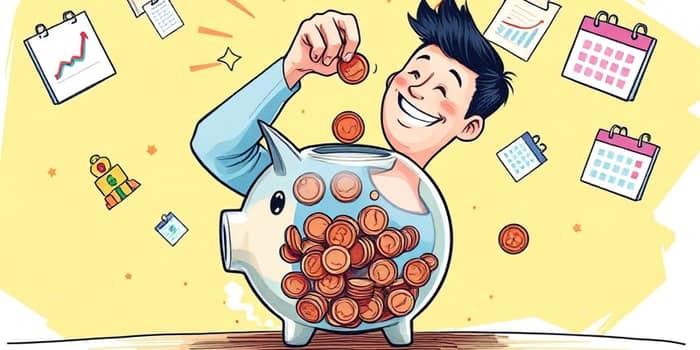Every dollar set aside today builds a stronger tomorrow. By understanding key data and applying proven methods, you can transform your financial future and achieve lasting peace of mind.
The Current Landscape of American Savings
The personal saving rate in May 2025 stands at 4.5% of disposable income, marking the portion left after taxes and routine spending that Americans choose to set aside. This rate is slightly below the 2024 average of 4.6% and reflects a long-term downward trend compared to the robust figures of the 1960s and early 2010s.
- Personal saving rate: 4.5%
- 2024 average: 4.6%
- Collective savings: $1.01 trillion in May 2025
- Q1 2025 rate: 3.97%
Though the saving rate has dipped, the sheer volume—over a trillion dollars—demonstrates a collective commitment to security. Seventy percent of U.S. economic activity is driven by consumer spending, so shifts in savings behavior reverberate across the broader economy.
Experts monitor this metric as a barometer of economic health: too low and families face vulnerability; too high and short-term consumer demand may soften. Finding balance is key.
Common Challenges and Barriers
The rising cost of living remains the leading obstacle to increasing savings. Housing, healthcare, and student debt continue to absorb large portions of household budgets, leaving less room for discretionary reserves.
About one in three banked households could not cover a month’s expenses if income stopped, highlighting widespread fragility. Women report less financial resilience than men, with 39% unable to meet costs for even a month, compared to 28% of men.
Generational dynamics further complicate the picture: Millennials (41%) and Gen Z (38%) are less prepared for emergencies than older cohorts, who often have larger savings cushions. Urban centers with steep living costs exacerbate these gaps, demanding targeted strategies for people in different regions.
Only one in ten households is fully satisfied with their savings level, signaling a deep desire for improvement and practical guidance.
Proven Strategies for Building Savings
Transform good intentions into results by adopting automated savings transfers and disciplined techniques. Consistency is the cornerstone of effective saving.
- Automate regular transfers from each paycheck
- Create sinking funds for predictable, irregular expenses
- Allocate windfalls—bonuses or tax refunds—to savings
- Explore high-yield savings accounts for better returns
Automated transfers remove temptation and ensure a steady flow of deposits. Sinking funds shield core reserves from one-off costs like repairs or holiday spending. By funneling at least 50% of windfalls into savings, you accelerate progress without feeling deprived.
Pair these methods with regular plan reviews and adjustments to account for life changes, income shifts, or evolving goals.
Setting Goals and Tracking Progress
Clear, attainable objectives give purpose to your efforts. Financial advisors recommend building an emergency fund covering three to six months of living expenses before tackling other ambitions.
- Emergency fund: 46% of savers prioritize this
- Vacation or travel: 33%
- Home purchase or education
- Retirement savings and large purchases
Use budgeting apps or spreadsheets to visualize progress over time and maintain momentum. Break larger targets into smaller milestones and celebrate each victory, reinforcing the habit loop that underpins sustained saving.
Adjust contributions seasonally to align with cyclical expenses or income changes, ensuring your strategy remains agile and effective.
The Psychology of Saving
Behavioral insights reveal that out of sight, out of mind can be a powerful ally. When money moves directly into savings accounts, it escapes the impulse to spend.
Visualization tools—like a savings thermometer or progress bar—tap into the brain’s reward system, making abstract targets tangible. Partnering with a friend or coach introduces accountability and mutual motivation, transforming saving from a solitary task into a shared achievement.
Address emotional spending triggers, such as stress or social pressure, by identifying alternative outlets—exercise, hobbies, or time with loved ones—to satisfy psychological needs without dipping into savings.
Building Resilience for the Future
Robust savings contribute not just to individual security but also to a stable, resilient economy. While higher savings rates can temporarily dampen consumer spending, they foster long-term prosperity by reducing vulnerability.
With 60% of Americans optimistic about their finances in 2025—and Gen Z leading at 70%—there is real momentum. Adopt a growth mindset, viewing setbacks as learning experiences that refine your approach.
Beyond emergency funds, consider long-term instruments like health savings accounts (HSAs) or retirement plans that offer tax advantages and compound growth. Conduct annual or event-driven reviews—marriage, new job, or a new child—to realign your plan with changing priorities.
Every step counts: set up an automated transfer today, define a vivid savings goal, or open a sinking fund. Your actions now build the foundation for financial peace, resilience, and opportunity tomorrow.
References
- https://www.bea.gov/data/income-saving/personal-saving-rate
- https://www.bea.gov/news/2025/personal-income-and-outlays-may-2025
- https://usafacts.org/articles/why-arent-americans-saving-as-much-as-they-used-to/
- https://www.nerdwallet.com/article/banking/2025-savings-report
- https://maristpoll.marist.edu/polls/the-state-of-savings-january-2025/
- https://www.statista.com/statistics/246234/personal-savings-rate-in-the-united-states/
- https://fred.stlouisfed.org/series/PSAVERT










